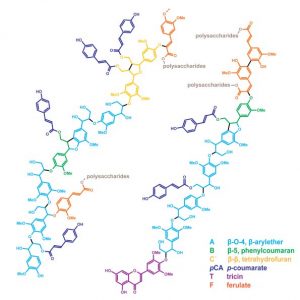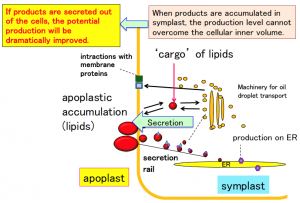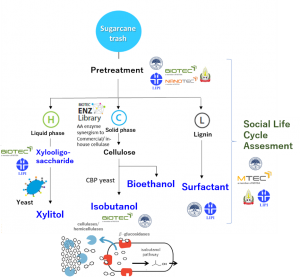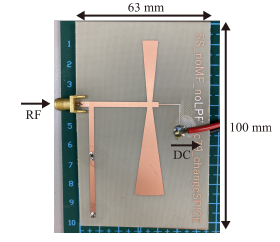2021 Activity Report for Mission 5-2: Establishing a Society with Reduced Dependence on Fossil Resources: Plants, Biomass, Energy, and Materials
Updated: 2022/06/01
Research 1: Tailor-made breeding of grass biomass through lignin bioengineering
RISH investigator(s): Toshiaki Umezawa, Yuki Tobimatsu
Outside collaborator(s): Tokushima University, Nara Institute of Science and Technology (NAIST), Hokkaido University, Korea University, The University of Hong Kong, National Research and Innovation Agency of Indonesia (BRIN), University of Wisconsin, Oklahoma University, CAS Shanghai Institute of Plant Physiology and Ecology, Wageningen University & Research, US Brookhaven National Laboratory, Toulouse Biotechnology Institute, Spanish National Research Council (CSIC), etc.
To explore new breeding strategies to improve the production of bioenergy and biomaterials from grass biomass, this project seeks to develop and characterize transgenic rice plants that produce biomass with variously modified lignin contents and structures. To this end, new lignin-modified transgenic rice lines are being developed via up- and/or down-regulations of lignin biosynthesis pathway genes. We are also working on the selection and breeding of grass biomass crop varieties that show superior lignin characteristics.
 |
 |
Figure: Lignin-modified transgenic rice plants grown in a greenhouse (left) and structural models of lignins in grass biomass or cell walls (right).
Selected Publications
- Lam et al., Deficiency in flavonoid biosynthesis genes CHS, CHI, and CHIL alters rice flavonoid and lignin profiles. Plant Physiol., 188: 1993-2011 (2022)
- Yamamura et al., A microscale protocol for alkaline nitrobenzene oxidation of lignins using a readily available reactor. Lignin, 2: 19-24 (2021).
- Lam et al., Tricin biosynthesis and bioengineering. Plant Biol., 12: 733198 (2021).
- Dumond et al., Termite gut microbiota contribution to wheat straw delignification in anaerobic bioreactors. ACS Sustainable Chem. Eng., 9: 2191-2202 (2021).
- Zhao et al., Monolignol acyltransferase for lignin p-hydroxybenzoylation in Populus. Plants, 7: 1288-1300 (2021).
+ 6 international journal papers
Research 2: Metabolite production platform using lipid-secreting plant cells
RISH investigator(s): Kazufumi Yazaki, Akifumi Sugiyama, Ryosuke Munakata
Outside collaborator(s): RIKEN
Plants have developed lipid secretion mechanisms to protect themselves from dryness since the land colonization of plants in ancient ages. The lipid secretion ability is especially prominent in epidermal cells, where wax and cutins as well as suberin are secreted. Besides, some other characteristic cell types related to oil glands and glandular trichomes are also responsible for secretion of lipid-soluble low molecular weight substances, like secondary metabolites. One of such examples is Lithospermum erhthrorhizon, in which root epidermal cells are secreting a large amount of secondary metabolic lipids, i.e., shikonin derivatives. The cultured cells of this plant retain the shikonin productivity of ca. 10% per cell dry weight. In this study, we are trying to develop a production system of high value lipid-soluble metabolites utilizing the lipid secreting ability of this cultured plant cells as a platform.
Selected Publications
- Ichino, T. and Yazaki, K., Modes of secretion of plant lipophilic metabolites via ABCG transporter-dependent transport and vesicle-mediated trafficking, Opin. Plant Biol., 66: 102184 (2022).
- Koeduka et al., Production of raspberry ketone by redirecting the metabolic flux to the phenylpropanoid pathway in tobacco plants, Eng. Commun., 13: e00180 (2021).
- Munakata et al., Natl. Acad. Sci. USA, 118: e2022294118 (2021).
- Yazaki, K., New stream on biosynthetic research of shikonin in Boraginaceae. Farumashia, 57 (8): 707 – 709 (2021).
Research 3: Conversion of biomass into chemical resources using a microwave and biological process
RISH investigator(s): Takashi Watanabe, Hiroshi Nishimura
Outside collaborator(s): Kyoto University ICR, Kyoto University IAE, Nippon Steel Engineering Co., Daicel Corporation, Thailand National Science and Technology Development Agency (NSTDA), National Research and Innovation Agency of Indonesia (BRIN), National University of Laos (NUOL), Al-Azhar University、etc.
A yeast that efficiently converts glycerol, a byproduct of biodiesel, to ethanol was bred using genome editing. This recombinant strain converts glycerol and glucose to ethanol simultaneously, thus enabling direct ethanol production without separating glycerol and sugar from the enzymatic hydrolysates of plant biomass after pretreatment using glycerol. We published this result and applied the method to sugarcane trash. In addition to Mission 5-2, this research is being conducted as a part of e-Asia project, which is being conducted jointly with the National Science and Technology Development Agency of Thailand (NSTDA), the National Research and Innovation Agency of Indonesia (BRIN), the National University of Laos, Graduate School of Energy Science of Kyoto University (KU), Institute of Advanced Energy of KU, and the Research Unit for Realization of Sustainable Society of KU. In the e-Asia research, research on pretreatment of sugarcane trash, molecular breeding of saccharification enzymes and isobutanol producing bacteria, synthesis of lignin-based surfactants, and microbial production of xylitol were conducted. In the JASTIP project, we are conducting research with Indonesia and Malaysia on the degradation of dye effluents, an environmental pollutants, using immobilized laccase from white rot fungi screened from the Southeast Asian region, and published a paper on this subject.
Selected Publications
- Khattab S. M. R. and Watanabe T., Efficient conversion of glycerol to ethanol by an engineered Saccharomyces cerevisiae strain, Environ. Microbiol., 87: e00268-21 (2021).
- Yanto et al., Biodegradation and biodetoxification of batik dye wastewater by laccase from Trametes hirsuta EDN 082 immobilised on light expanded clay aggregate, 3 Biotech., 11: 247 (2021).
Research 4: Design of green biomass conversion based on an analysis of branched structures on lignocellulose
RISH investigator(s): Hiroshi Nishimura, Takashi Watanabe
Outside collaborator(s): Chalmers University of Technology, Wallenberg Wood Science Center (WWSC), Kyoto University ICR, etc.
Advanced utilization of plant biomass needs a deeper understanding of the molecular structure of lignocellulose polymers. In particular, branched structures on lignocellulose, e.g., lignin-polysaccharide linkages, are critical to elucidate for converting biomass to useful chemicals, materials, and energy. Here, we established a highly concentrated fraction of lignin-carbohydrate complexes and purified by combining of carbohydrase enzymatic treatment and sequential chromatography. We succeeded in proving the covalent bond between lignin and hemicellulose by two-dimensional and three-dimensional NMR method. We are now trying to develop the environment-friendly green system of biomass conversion based on the accurate molecular structure analysis.
Figure: Study overview of the lignin-carbohydrate linkage elucidation
Selected Publications
- Mikame et al., Natural organic ultraviolet absorbers from lignin, ACS Sustainable Chem. Eng. 9: 16651-16658 (2021).
- Li et al., Conversion of Beech Wood into Antiviral lignin-carbohydrate complexes by microwave acidolysis, ACS Sustainable Chem. Eng. 9: 9248-9256 (2021).
- Saito et al., Identifying the interunit linkages connecting free phenolic terminal units in lignin, ChemSusChem, 14: 2554-2563 (2021).
Research 5: Development of high-strength products based on cellulose and chitin nanofibers
RISH investigators: Hiroyuki Yano, Kentaro Abe
“Cellulose nanopaper”, which is composed of a porous network of cellulose nanofibers isolated from plants, exhibits excellent mechanical properties with high strength and toughness while being lightweight. Therefore, it is currently being widely studied alongside carbon nanotube nanopaper and graphene nanopaper. We are also energetically researching the manufacturing method of cellulose nanopaper and its detailed mechanical properties.
In this study, we investigated the mechanical performance of cellulose nanopaper in a low temperature environment of -70˚C. The tensile properties at low temperature and the effect of moisture on their physical properties were compared with those of ordinary polymer films, and the unique low-temperature performance of crystalline cellulose nanopaper was clarified.
Selected Publications
- Yang et al., Toughened hydrogels through UV grafting of cellulose nanofibers, ACS Sustainable Chem. Eng., 9: 1507-1511 (2021).
- Abe K, Compression-molded products based on wet ball-milled wood and effect of various preparation conditions, Bioresources, 16: 3934-3941 (2021).
- Okahisa et al., Optically transparent silk fibroin nanofiber paper maintaining native β-sheet secondary structure obtained by cyclic mechanical nanofibrillation process, Today Commun., 29: 102895 (2021).
Research 6: Development of energy storage device from biomass
RISH investigator(s): Toshimitsu Hata
Research collaborator(s): Lignyte Inc., National Research and Innovation Agency of Indonesia (BRIN), Osaka Prefecture University, etc.
The development of energy devices from biomass is advantageous in that they are renewable, low cost, and abundant. Carbonization and gas activation of Abies sachalinensis heat-treated at 350°C was followed by carbonization and gas activation at 800°C. Analysis of CO2 gas adsorption isotherms of the resulting porous carbon at 0°C showed that a maximum surface area of 558m2/g was obtained by steam activation. The carbon electrode obtained from the sample exhibited a capacitance corresponding to the surface area, indicating its potential application as an electrode for electric double-layer capacitors.
Presentations
- Hata, T. et.al. “Production and Characterization of Activated Carbon from Heat-Treated Ammonia-Adsorbing Abies sachalinensis,” The 72nd Annual Meeting of Japan Wood Research Society in Nagoya-Gifu, 2022.3.
Research 7: Micropore analysis of carbonized lignin for use in low earth orbit
RISH investigator(s): Toshimitsu Hata, Yuki Tobimatsu, Hirotsugu Kojima
Research collaborator(s): Kobe University、National Institute of Technology, Nagano College
Lignins with different aromatic units (MWL) were prepared from beech and cedar in order to investigate the possibility of using wood in the space environment. To investigate the resistance to atomic oxygen (AO), which is a problem in low orbit space environment, the above samples carbonized at at 700°C for 1 hour under nitrogen gas flow were irradiated with AO at a flux of 2 × 1015 atoms/cm2/s for 15,002 shots at 3 Hz (about 83 minutes). The morphology of the material surface was observed by scanning electron microscopy, and it was observed that microstructures, which were caused by AO irradiation, were uniformly distributed on the cedar MWL surface.
Research 8: Development of IoT technology with wireless power transfer via microwaves
RISH investigator(s): Naoki Shinohara, Tomohiko Mitani
Research collaborator(s): Panasonic Co., MinebeaAtsumi Inc., etc.
Toward a post-fossil-fuel society, IoT (Internet Of Things) technology for a sophisticated society is required. We are developing an unconscious wireless charging system and battery-less IoT sensor with wireless power transfer (WPT) via microwaves. We are negotiating new regulation of the WPT with Ministry of Internal Affairs and Communications, as the 1st step of an indoor WPT powered vital sensor in nursing house and as the 2nd step of an outdoor WPT for infrastructure measurement system inside a tunnel. As a result of WPT R&D and the negotiation, the new WPT regulation as the 1st step will be published in June, 2022 and commercial application of the wireless powered IoT sensor will be produced soon.
Fig. Developed Small-Size 920MHz-Band Rectifier for Wireless Powered Vital Sensors
Selected Publications
- Kawai, K., et al, “Design of High Efficiency and Low Power Rectifier Circuit for 920 MHz Wireless Power Transfer”, Proc. International Union of Radio Science (URSI) General Assembly 2021
+ 3 other publications





-300x154.png)


